Last Updated on May 12, 2025
Asphalt is a popular and cost-effective material for driveways due to its affordability and ease of maintenance. However, it’s also prone to moss, algae, and lichen growth—especially in areas with shade, moisture, and organic debris. Moss on your asphalt driveway can make it unsightly, slippery when wet, and even hazardous to walk or drive on. In addition to moss, oil stains can degrade the appearance and longevity of your asphalt driveway—addressing both is essential for proper maintenance. In this guide, you’ll learn several effective ways to remove moss from your asphalt driveway, using both home remedies and commercial products.
How to Remove Moss from Asphalt Driveway: Simple & Effective Methods
Moss growth on asphalt driveways can compromise both safety and surface integrity. This guide outlines effective, proven methods to remove moss and maintain a clean, durable driveway.
☀️ Expose Moss to Sunlight
The simplest and most natural way to remove moss is by exposing the affected area to direct sunlight. Moss thrives in damp, shaded environments, and UV rays can kill moss by drying it out.
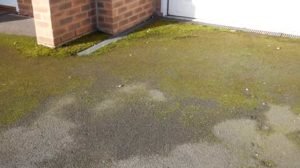
Here’s how to do it:
- Move any patio furniture, cars, or planters blocking sunlight.
- Trim or prune tree branches that cast shade on the driveway.
- Allow consistent sunlight to reach the mossy area.
Sunlight alone may not completely remove the moss, but it weakens it significantly. For best results, follow up with a treatment using vinegar, bleach, or a commercial moss remover.
🧴 Use Bleach (with Caution)
If sunlight exposure isn’t possible, bleach is a powerful option for killing moss on asphalt surfaces. However, it’s a harsh chemical, so use it with care—especially around plants, kids, and pets.
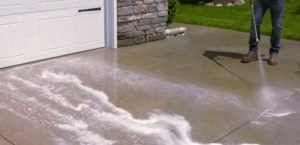
To use bleach safely:
- Mix equal parts bleach and water in a sprayer or bucket.
- Apply the solution directly to the moss-covered area.
- Let it sit for 15–20 minutes.
- Scrub the area with a stiff-bristled brush.
- Rinse thoroughly with a hose.
🛑 Safety tip: Wear gloves, goggles, and old clothing. Avoid allowing bleach to touch nearby grass or flower beds—cover plants with a tarp if needed.
🧂 Try Baking Soda for a Gentle Approach
If you prefer a less aggressive, eco-friendly alternative, baking soda is a good option. While not as powerful as bleach or chemical sprays, it’s effective for light moss buildup.
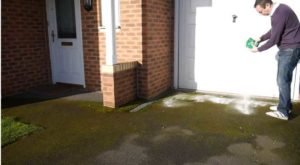
How to use baking soda:
- Sprinkle a generous amount of baking soda directly onto the moss.
- Let it sit overnight.
- Sweep the area with a broom or scrub with a deck brush the next day.
- Rinse thoroughly.
This method may need to be repeated multiple times if the moss is thick or deeply rooted. Thus, If you’re looking for a gentle yet effective way to remove grass or moss from your driveway, baking soda offers a natural alternative without harsh chemicals.
💧 Use Commercial Moss Removers
For fast and professional-grade results, consider commercial moss removers like liquid moss sprays. These products are formulated to penetrate and kill moss spores effectively but often contain chemicals that may irritate the skin or lungs.
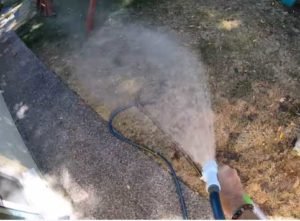
If you use a commercial moss killer:
- Apply the product evenly on the mossy surface.
- Let it soak for at least 10 minutes (check the label).
- Do not let it dry on the asphalt.
- Rinse with a power washer or garden hose.
- Remove the dead moss manually.
- Repeat as needed to eliminate all spores.
⚠️ Important: Wear protective gloves, eyewear, and a mask. If you have pets or children, consider using eco-friendly or biodegradable formulas.
🧴 Use Vinegar as a Natural Moss Killer
Vinegar is another effective, eco-friendly option for removing moss from your asphalt driveway. While it may require multiple applications for significant results, it’s a safe alternative for those avoiding harsh chemicals.
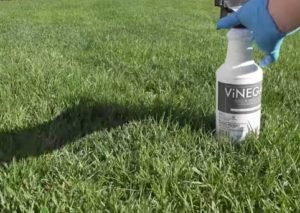
However, vinegar is best for small or moderate moss growth. If the moss is widespread, you may need to combine this method with a commercial moss remover.
✅ How to apply vinegar:
- Mix equal parts of white vinegar and water in a spray bottle.
- Spray the solution generously over the mossy area.
- Allow it to sit for at least 15 minutes.
- Scrub the spot using a stiff deck brush or push broom.
- Rinse thoroughly using a garden hose or pressure washer.
- Repeat the process if moss remains.
⚠️ Tip: Avoid spraying vinegar on nearby plants as it can damage or kill them. Use a tarp or apply carefully around landscaping.
🔥 Use Boiling Water (Safe & Natural)
Boiling water is a chemical-free and plant-safe moss removal method. While it may not be as potent as bleach or vinegar, it’s an excellent first step, especially when combined with scrubbing or a moss remover.
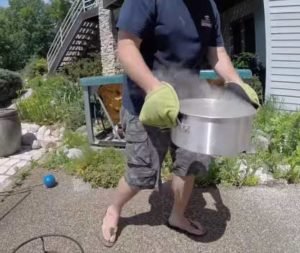
✅ How to use boiling water:
- Bring water to a full boil.
- Pour it directly over the moss-covered area.
- Use a stiff brush to scrub away the loosened moss.
- Rinse with water to clean the surface.
This method works best for minor moss infestations and is ideal for homes with pets or gardens nearby.
🚿 Use a Power Washer or Garden Hose
If you’re looking for a non-chemical option, a power washer or high-pressure garden hose can physically dislodge moss from the surface. While not always as effective alone, it works well when used in combination with bleach or vinegar treatments.
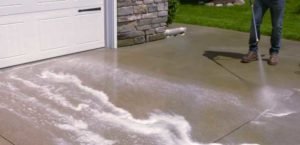
✅ Tips for best results:
- Use a pressure washer with a fan nozzle to avoid damaging the asphalt.
- For garden hoses, connect to a pump sprayer for added pressure.
- Pre-treat the area with bleach or vinegar before rinsing.
- Scrub with a stiff broom before rinsing for better removal.
🌿 Bonus: This method is safe for nearby plants and requires no chemicals.
Related article: What is the best time to seal a new asphalt driveway?
🧼 Summary: Best Way to Remove Moss from Asphalt Driveway
Moss, algae, and lichens not only make your asphalt driveway look unkempt—they can also lead to safety hazards and surface degradation if left untreated. Fortunately, there are multiple natural and commercial methods available to safely and effectively eliminate moss.
Whether you choose vinegar, boiling water, bleach, or a commercial moss remover, the key is consistency and proper safety measures.
✅ Pro Tip: Always wear gloves, goggles, and protective clothing when handling bleach or any chemical-based moss killer.
❓ FAQs – Removing Moss from Asphalt Driveway
Q. What causes moss to grow on asphalt driveways?
A. Moss thrives in damp, shaded areas with minimal sunlight. Poor drainage, overhanging trees, and lack of regular maintenance can encourage moss growth on asphalt surfaces.
Q. Is it safe to use bleach on an asphalt driveway?
A. Yes, bleach is effective for killing moss, but it should be used with caution. Protect nearby plants and always wear gloves and eye protection. Avoid overuse as it can damage landscaping.
Q. Can I use vinegar to kill moss on my driveway?
A. Yes, vinegar is a natural moss killer. It’s safe and eco-friendly but may require multiple applications for tough infestations. Avoid contact with grass and plants.
Q. What is the fastest way to remove moss from asphalt?
A. Using a commercial moss remover combined with a power washer typically delivers the fastest and most effective results.
Q. Will a pressure washer alone remove moss completely?
A. A power washer can dislodge moss but may not kill spores. For best results, pre-treat with a moss-killing solution and scrub before rinsing.
Q. How do I prevent moss from coming back?
A. Regularly clean your driveway, trim overhanging branches to let sunlight in, and ensure proper drainage to prevent moisture buildup.
Q. Is boiling water an effective moss removal method?
A. Boiling water can help loosen moss, especially in small patches, but it’s best used alongside scrubbing or chemical treatments for lasting results.
Q. Can I seal my driveway after moss removal?
A. Yes. After thoroughly removing moss and letting the surface dry, applying a driveway sealer can protect the asphalt and prevent future moss growth.

